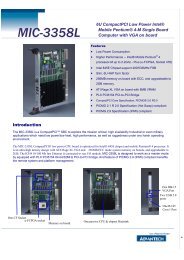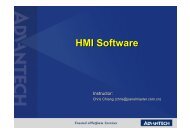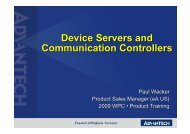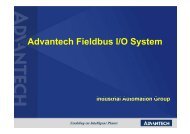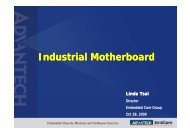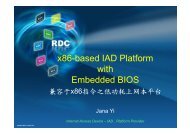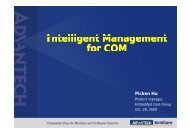industrial wireless book special edition - Networking ...
industrial wireless book special edition - Networking ...
industrial wireless book special edition - Networking ...
You also want an ePaper? Increase the reach of your titles
YUMPU automatically turns print PDFs into web optimized ePapers that Google loves.
Fig. 1. Field device meshing and infrastructure meshing: The OneWireless system supports field device meshing and<br />
infrastructure meshing topologies in either standalone mode, or in combination.<br />
The ISA100.11a standard<br />
So as to realise the maximum benefits offered<br />
by meshing, both field device and infrastructure<br />
meshing topologies need to be supported<br />
simultaneously and seamlessly in a single<br />
network. This is one of the core requirements<br />
of the ISA100.11a standard for <strong>wireless</strong> field<br />
instruments, which was developed by ISA100's<br />
500-plus members representing the plant<br />
automation industry. This technology was<br />
designed for use in remote applications with<br />
low frequency update rates, as well as in<br />
control and critical monitoring applications<br />
with high frequency update rates.<br />
ISA100 members ensured that ISA100.11a<br />
transmitters could operate with both field<br />
device and infrastructure meshing topologies.<br />
Figure 1 illustrates how ISA100.11a field<br />
instruments operate in either field device<br />
meshing or infrastructure meshing mode.<br />
A comparison<br />
Table 1 (over page) shows the characteristics<br />
of a field device meshing topology versus that<br />
of an infrastructure meshing approach.<br />
Latency. The ISA100.11a standard is intended<br />
to optimise the battery life of <strong>wireless</strong> transmitters.<br />
When in field device meshing/routing<br />
mode, ISA100 field instruments wake up on a<br />
periodic basis to listen to other transmitters<br />
and route data based on reporting rates. This<br />
capability allows field instruments to save<br />
power and maximise their battery life, which<br />
effectively translates to lower latency.<br />
In a star meshing topology, routing infrastructure<br />
nodes listen and route data in<br />
real-time. This is possible since the devices are<br />
line-powered. Field instruments simply need to<br />
transmit their data to the routers. Network<br />
timeslot allocation is much easier in an infrastructure<br />
meshing topology.<br />
As just described, there is a significant<br />
difference in data latency between a field<br />
device meshing network and an infrastructure<br />
I n d u s t r i a l W i r e l e s s<br />
sponsored by Advantech<br />
<strong>industrial</strong> ethernet <strong>book</strong><br />
31



